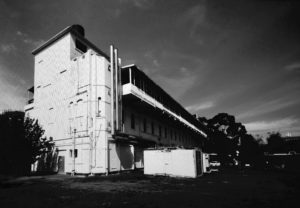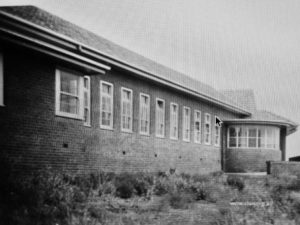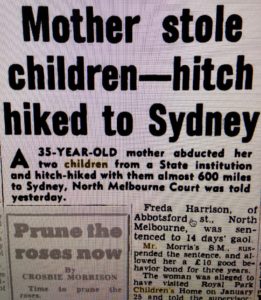- ROYAL PARK IN PARKVILLE – THE DEPOT AND MUCH MORE
Against that back-story we come to Royal Park in Parkville. No site has had such a confusing history as Royal Park. You get a sense of this in its more than a dozen alternative names and functions over the years (matched by repeated changes of names of the Department and its agencies as an indicator of confused purposes.)
Children were housed at Royal Park before the formal establishment of the Royal Park Industrial School in 1875. As a response to overcrowding elsewhere, children were housed at the former Royal Park Lunatic Asylum in 1867.
The Royal Park Industrial School—a workhouse/warehouse for children—opened at 900 Park Street, Parkville in 1875. It was for girls only at first, until around 1880 when the girls were transferred to the Industrial School at Geelong, and boys from Sunbury’s Industrial School came to Royal Park to await boarding-out placements (more on boarding-out shortly).
Meanwhile, following damning reports from official visitors[1] and under the influence of the child-savers (more later), the government was re-thinking its approach. As Shurlee Swain points out, ‘
Industrial schools did not make children industrious; they were plagued by disease, disorder and a sense that the children compared poorly with those growing up within families.[2]
In 1887 it split the old department into two:
- Department for Neglected Children under the Neglected Children’s Act 1887 and
- Department for Reformatory Schools for convicted juveniles under the Juvenile Offenders’ Act 1887.
The new Neglected Children’s Act 1887 ruled that there would be no new Industrial Schools built (though they lingered for decades).
Boarding-out (foster care) had become the much-preferred option from the mid 1870s. Boarding-out was much cheaper and, it was argued, more akin to real family life. In 1888 the Head of the Neglected Children’s Department gave the policy ringing endorsement. And the child savers were vocal supporters.
However, boarding-out was not universally popular. There were some who thought the child savers were persecuting children in order to ‘foist them on the State’.[3] For example the North Melbourne Magistrate, a certain Dr Lloyd, declared that while charitable sentiment was commendable,
…it sometimes became sickly sentiment, and augmented the tide of state socialism which was setting in.[4]
Nevertheless, boarding-out firmed as government policy. Almost surreptitiously during the 1890s, a period of deep depression, the government began to extend the boarding-out system to the children’s own mothers. They would pay impoverished but respectable mothers to keep their children off the welfare treadmill.
At first, they made the mothers go through a legal charade of having their children declared wards of the state, but realised in due course that this was not warranted. In 1919 they made these payments legal: an early form of deserted wives’ or widows’ pension child endowment or family payment. It wasn’t until 1942 that the Commonwealth Child Endowment scheme was introduced.
With industrial schools being replaced by the boarding-out system, the government imagined that the only government-run facility needed would be a small institution at Royal Park to hold children awaiting placement.
The Royal Park Depot became that sole reception centre for children committed to State care—whether they were entering the welfare or the juvenile justice system—from about 1880 right through to 1961.
During the Great Depression, boarding-out all but collapsed as a viable alternative to institutionalisation largely because the weekly rate of payments failed to keep up with the rising cost of living. So chronic overcrowding at Royal Park intensified. Dr Norval Morris, a criminologist from the University of Melbourne was quoted in 1952 as saying that instead of Royal Park being a clearing house, it had become ‘a blocked sink’.[5]

Royal Park has never out of the media for long. For example, there was a spate of complaints in 1914 that sprang from the deaths of children at the institution. The law required all sudden or abnormal deaths of children to be investigated—except for state wards. The Department of Neglected Children rejected public demands for an inquiry into these deaths. An editorial in The Age implied the Department had some ‘ugly facts’ to hide.[6]
As an aside, I remember harbouring the same suspicion when I learned that my mother’s sister, Joyce, had died, at age 12, while she was an inmate of the Ballarat Orphanage in 1933. There was no inquest. The father of the Orphanage Superintendent happened to be an undertaker, and Joyce was buried in an unmarked mass grave, without her family being informed. And to make matters worse, the death certificate record’s Joyce’s grandmother as her mother.

Anyway, back to Royal Park: the whiff of scandal about the secret deaths and insanitary conditions at the site led the National Council of Women to call for the appointment of an honorary board for the management of Royal Park and State Wards generally. The Chief Secretary (the responsible Minister) did not relish this advice, and hit back hard accusing the Council of Women of making wild, misleading and reckless statements. He ‘would not trust women in any position of responsibility’, he declared.
They appear to be becoming a lot of mischievous busybodies. I think that these women would be better employed if they were engaged at home in looking after their domestic duties, and were leaving public business to those who are more capable of attending to it.[7]
Hardy gracious or politically prudent: one of the prominent members of the National Council of Women was Mrs Alfred Deakin, wife of the former Prime Minister.
Allegations of poor management and ill treatment of children at Royal Park continued to run in the press. In 1922 the Age newspaper declared the Department was as neglected as the children it was supposed to nourish.[8] In that year, a complaint signed by nineteen female employees got as far as Cabinet—which declined to interfere.[9] Some of the employees lodging the complaints were then sacked.[10]
One of the recurring problems was the lack of consistent policy about the purpose of the site. In his Annual Report for 1923 the Medical Officer and Superintendent of Royal Park, Dr Derham reported that there were five categories of children:
- those admitted to state ‘care’ while awaiting placement in an orphanage or foster care
- those waiting to go on service or those who had been returned therefrom because they were unsatisfactory
- children detained on remand
- children suffering from defects of various kinds who were being held temporarily; and
- mentally and physically defective children who were unfit for ‘boarding out’ or ‘service’ and for whom Royal Park was a permanent or semi-permanent home.[11]
Dr Derham noted that the youngest resident on site was one day old, the oldest was seventeen. But what bothered him even more was the mix of children: ‘
It is very wrong for normal children to be associated with defective children, whose immoral tendencies are as marked as their mental backwardness.[12]
Not that there were many ‘normal’ children if you relied on the advice of Dr K.S. Cunningham, who would go on to become the first Director of the Australian Council for Educational Research. He conducted IQ tests on the children at Royal Park and reported in 1926 that up to 90 percent were below normal intelligence, and moreover,
Although it is only a matter of guesswork, it may be estimated that of all children under the care of the Department 40 per cent are cases for whom it would be advisable to provide care and training either permanently or for a number of years. The majority of these would be cases calling for permanent care.[13]
The eugenics movement had been strong in Melbourne in the 1920s and 1930s. A member of the visiting committee of the depot, Sir James Barrett, told an inquiry into the flogging of a 14 year-old boy at the North Melbourne court in 1927, that the use of corporal punishment was
absolutely necessary [for] maintaining of discipline at such an institution with its proportion of inherently diseased, morbid and degenerate boys.[14]
The following year, The Argus reported complaints that boys on remand from the Children’s Court awaiting trial were compelled to mix at the remand depot Royal Park with
convicted boys of strong criminal tendencies, mental deficients, and, sometimes, moral perverts…[15]
I’m reminded that in 1940 my brother and I were sent to the Royal Park Depot and, from there, were boarded out to a woman in Northcote. She returned us to Royal Park after nine days. She couldn’t keep us, she said, ‘because of their habits’. No details. I was aged 2 and Bob 3½. Perhaps we were ‘mental deficients’ or ‘moral perverts’.
Well, perhaps not! In 1933, the newly-formed Department of Mental Hygiene relieved Royal Park of some of its ‘burdensome’ children when it established Travancore in Flemington Street, Flemington in 1933. Travancore’s initial mandate was for
children who, although mentally defective, were capable of receiving benefit from special instruction.

It had a residential centre, a school and a clinic where children were medically examined and psychologically assessed, and were kept until the age of 14.
In 1940, Dr Guy Springthorpe described the operations at Travancore:
Admission is restricted to types as defined in the new Act [the Mental Deficiency Act 1939] and does not include lower grade defectives. The function of the school is not only to provide education and domestic care, but to promote all-round development…to the fullest extent possible; and by so doing, also to prevent psychological disorders and maladjustments. This is in accord with the abundant evidence that many such children are capable of leading happy lives and of becoming socially useful…[16]
A newspaper article in 1941 referred to changing attitudes towards ‘mentally retarded children and adults’. It even expressed a hope that, now that prejudice was decreasing, ‘they will be able to contribute to the national war effort’![17]
In 1968 Travancore ceased to function as a centre for intellectually disabled children and became the Travancore Psychiatric Developmental Centre, a residential centre for emotionally disturbed children. Since 2009, the Travancore School delivers a number of programs linking the mental health and education services.
Meanwhile, the Royal Park site remained notorious. For example, in 1936 an official told a Parliamentary hearing that the building for girls was ‘unfit for human habitation’ and (like the Benevolent Asylum in North Melbourne) it had been condemned by the Fire Brigade Board.[18]
In 1952 two girls escaped from the Delinquent Girls Home there, and, when they were arrested and returned, they were taken to Pentridge Prison—they were aged 15 and 13. The older girl had already had a stretch in Pentridge. And there had been other girls in Pentridge before these two.[19] The Chief Secretary said there was nothing he could do about getting the young girls out of gaol because the government could not interfere with a court’s ruling.[20] Where there’s no will, there’s no way!
However, here’s a mother finding both the will—and the way. Freda Harrison of Abbotsford Street, North Melbourne, had two children, Monica aged 11 and Vernon aged 13 in Royal Park. A friend said to Mrs Harrison, ‘If they were my children I would take them away.’ Well, Freda asked if she could take her children to the cinema one afternoon.

After four months with her children in Sydney, she returned to Melbourne, was arrested and sentenced to 14 days in prison for repossession of her own children. However, the sentence was suspended and, pending an inspection of her home, she was allowed to keep her children.[21]
In 1955 Royal Park became Turana (an Aboriginal word meaning rainbow). In the following years, Royal Park was progressively stripped of most of its diverse functions. It began pioneering the family group home model for children as an alternative to the established system of large institutions. Soon, most of the young children were housed in cottages on the site, and the original buildings were used exclusively for ‘delinquent girls’ and adolescent boys incarcerated at Turana Youth Training Centre (and its several alternative tags).
Turana remained the main government reception centre until 1961. You may be aware that in 2015, the Royal Commission exposed the infamous maltreatment of children and young people at Royal Park in the period between the 1960s and the early 1990s.[22]
——————————————————————————-
[1] James H Graves, Chairman, Reports of the Visiting Committee to the Industrial and Reformatory Schools of Victoria, with the Correspondence Relating Thereto, Government Printer, Melbourne, 1880.
[2] Shurlee Swain, History of Australian inquiries reviewing institutions providing care for children, Royal Commission into Institutional Responses to Child Sexual Abuse, Sydney, 2014, p. 6.
[3] Qu. In Scott & Swain, p. 54.
[4] The Argus, 26 November 1897, qu. In Scott & Swain, p. 54.
[5] ‘State “stingy to children”’, The Argus, 1 October 1952, p. 5.
[6] ‘Official Secrecy: Neglected Children Department: No Notification of Deaths’, The Age, 4 May 1914, p. 6.
[7] ‘Wards of the State: Conditions of Royal Park Depot: Minister and Women’s National Council: “A Lot of Mischievous Busy-bodies”’ The Age, 29 May 1914, p. 14. A similar report was published on the same day in the competing morning paper, The Argus.
[8] ‘A state of official chaos: A department without a head,’ The Age, 19 January 1922, p. 6.
[9] ‘Neglected Children’s Home: Charges by employees: State government will not interfere’, The Age, 18 July 1922, p. 7; ‘Children’s Home: Deputation to Minister: cruelty alleged’, The Argus, 27 July 1922, p. 8.
[10] ‘Matron Denies Allegations’, The Argus, 28 July 1922, p. 11.
[11] Department for Neglected Children and Reformatories, Annual Report 1923, p. 3.
[12] Department for Neglected Children and Reformatories, Annual Report 1924, p. 6.
[13] Dr KS Cunningham, ‘Report on Intellectual Status of Children under Care of Children’s Welfare Department’, in Annual Report of Department of Children’s Welfare 1927)
[14] ‘Flogging at Royal Park: Schoolmasters Give Evidence: Views on Use of the Strap’, The Age, 18 November , 1927, p. 12. See also: Flogging a Boy: Board of inquiry Opened: Evidence of strapping and bruises; The Age, 9 November, 1927, p. 19. Selected children told the coroner that punishment was fair and reasonable, The Age, 11 November, 1927, p. 7.
[15] ‘Delinquent Boys: Conditions At Royal Park: Mr. Prendergast to Inspect’, The Argus, 20 August 1928, p.10. See also ‘Delinquent Boys: Problem of the Mentally Defective: Medical Superintendent’s Recommendations,’ The Age, 19 November 1924, p. 12.
[16] Guy Springthorpe, ‘The Treatment of Mental Deficiency in Victoria,’ Meeting of the Medico- Legal Society 28 September 1940: http://mlsv.org.au/wp-content/uploads/2013/08/28th-September-1940-The-Treatment-of-Mental-Deficiency-in-Victoria-by-Guy-Springthorpe-M.R.C.P.-.pdf
[17] How Travancore helps, The Argus, 4 January 1941, p. 7. In early 1942, Travancore was evacuated, when the buildings at Flemington were required by the military. Travancore relocated to Hepburn Springs in rural Victoria and the girls who were in employment at the time of transfer were engaged at the Textile Mills at Daylesford. The annual report of the Department of Mental Hygiene in 1943, claimed they gave ‘complete satisfaction to their employer’. Travancore returned to Flemington in January 1944. At that time, the residents who had worked in the textile mill at Daylesford were placed in employment at the Yarra Falls Spinning Mills. The Department reported that the management of the Mills ‘has commented favourably both on their behaviour and industrial ability’.
[18] “’Unfit for Human Habitation”, Shelter for State Wards’, The Argus, 17 September 1936, p. 4.
[19] The Victorian Parliament heatedly debated the use of the adult prison for holding ‘delinquent girls’. The public uproar continued in the press throughout September 1952.
[20] ‘Pentridge isn’t the Only Place, Expert says: “Courage can help gaol girls”’ The Argus, 9 September 1952, p. 14; ‘Girl of 15 back in Pentridge—with another aged 13,’ The Argus, 23 September 1952, p.1. A group of residents of Melbourne’s more affluent suburbs sent a letter to The Argus: It is a disgrace to our present child welfare institutions that such girls should leave their care labelled incorrigible, and be forced…to be sent to Pentridge and forced to mix with hardened criminals.…[W]e demand that you give the people of Victoria…and especially the mothers, the opportunity of rectifying what is surely a blot upon our social system. ‘Has anyone got an old dungeon to let?’ The Argus, 12 September 1952, p. 2.
[21] Argus, 8 June 1956, p. 12.
[22] Royal Commission into Institutional Responses to Child Sexual Abuses, 2015, Report of Case Study No. 30: The response of Turana, Winlaton and Baltra, and the Victorian Police and the Department of Helath and Human Services Victoria to allegations of child sexual abuse, The Commission, Sydney, 2016.